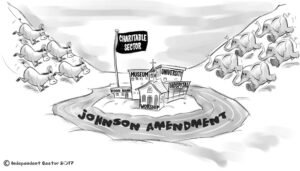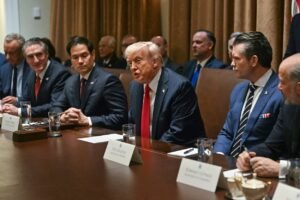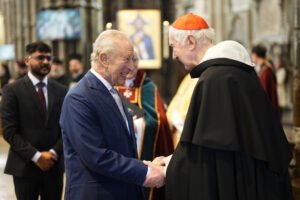Unpacking the Minnesota Shooting: Exploring the Background of the Suspect and Christian Nationalism
Introduction
The recent shooting incident in Minnesota has sent shockwaves through the local community and reverberated across the nation. This tragic event has not only raised concerns regarding public safety but has also ignited discussions about the underlying motivations that led to such an act of violence. As the investigation unfolds, attention is turning to the background of the suspect and the potential influence of Christian nationalism on their actions.
On the day of the shooting, the atmosphere in Minnesota shifted dramatically, as first responders and law enforcement raced to the scene. The immediate aftermath saw a surge of community support for the victims and their families, highlighting the resilience of the affected population. Yet, as details emerged, it became evident that this incident was not an isolated event. Rather, it fits within a broader narrative of violence that has been linked to extremist ideologies, including Christian nationalism.
Christian nationalism, characterized by the belief that the nation should be defined by Christian values and identity, has gained traction in certain segments of American society. The potential for this ideology to influence behavior—particularly when intertwined with a perceived sense of righteousness—raises significant questions about the motivations behind the actions of the shooter. While the investigation is still ongoing, the profile of the suspect may provide clues into how deeply ingrained beliefs can manifest in destructive ways.
This blog post aims to explore the relationship between acts of violence and the ideologies that underpin them, particularly examining how Christian nationalism may have contributed to the motivations of the perpetrator. By unpacking these complexities, we aim to foster a better understanding of the factors that can lead to extreme actions, the impact on local communities, and the broader implications for society as a whole.
Overview of the Incident
On the evening of October 12, 2023, a tragic shooting occurred at the Mill City Plaza in Minneapolis, Minnesota, leaving a profound impact on the community. The incident unfolded around 7:30 PM as a group of individuals gathered for a local event aimed at promoting community engagement and development. The atmosphere, which started off vibrant and filled with hope, quickly transformed into chaos when an unidentified suspect opened fire indiscriminately into the crowd.
Witnesses reported hearing multiple gunshots, creating panic among attendees. Emergency services were quickly deployed to the scene, with police officers and paramedics responding within minutes. Tragically, five people were pronounced dead at the scene, and several others sustained serious injuries, leading to immediate medical treatment at nearby hospitals. Victims’ ages ranged from young adults to older individuals, reflecting a broad cross-section of the community.
In the wake of the shooting, law enforcement took decisive action by establishing a perimeter and securing the area to gather crucial evidence. The suspect fled the scene but was apprehended later that evening, leading to a comprehensive investigation that focused on the motivations behind the attack. Eyewitness accounts and surveillance footage were collected to aid in understanding the circumstances surrounding the shooting.
The aftermath of this horrific event prompted swift reactions from both community leaders and the media. Press conferences were held to address public concerns, while community vigils emerged in honor of the victims. Local news outlets provided extensive coverage, with stories highlighting not only the identities of the victims but also the community’s resilience in the face of such violence. This incident has left a lasting scar, necessitating ongoing conversations about safety and the underlying issues surrounding gun violence in America.
Understanding Christian Nationalism
Christian nationalism is a political ideology that intertwines Christian faith and national identity, advocating for a nation as fundamentally defined by its Christian heritage and values. It posits that the United States, along with other countries, should be governed by laws and policies that align with a Christian worldview. This belief system often emphasizes the idea that America has a unique covenant with God, rooted in its early history and foundational documents, which were influenced by Christian principles.
At its core, Christian nationalism asserts that Christians should not only participate in the political process but also play a dominant role in shaping public policy to reflect their beliefs. Adherents often view themselves as protectors of a divinely ordained social order, often seeing secularism, liberalism, and multiculturalism as threats to their vision of the nation. This perspective fosters a sense of urgency among supporters to defend their concept of a Christian America against perceived moral decline and identity erosion.
Historically, the roots of Christian nationalism in the United States can be traced back to the colonial period, although the movement gained significant traction in the 20th century, particularly during the post-World War II era. Key figures, such as Billy Graham and various evangelical leaders, played pivotal roles in promoting the blend of faith and patriotism. The Civil Rights Movement, alongside the rise of the New Christian Right in the late 20th century, further catalyzed the movement, as conservative Christians sought to assert their influence on political agendas, especially in response to social changes that challenged traditional values.
The ongoing influence of Christian nationalism is evident in contemporary politics, where it manifests through various advocacy groups and political candidates who align with its ideals. As these beliefs continue to permeate American culture, the impact on public discourse and policy remains significant, reflecting the complexities inherent in the relationship between religion and nationalism.
The Suspect’s Background
The individual at the center of the Minnesota shooting incident has a complex background that warrants thorough examination. Born in the late 1990s, the suspect grew up in a suburban community, where they were reportedly raised in a Christian household. This upbringing initially appeared to be typical, marked by family functions and church attendance, which later became a cornerstone of their identity.
As an adolescent, the suspect was a part of various youth groups that upheld conservative Christian values. These gatherings provided an avenue for community engagement but also exposed them to discussions that increasingly echoed themes of Christian nationalism, a viewpoint emphasizing the need to intertwine religious beliefs with national identity. Such discussions may have influenced their worldview over time, steering them towards more extreme ideologies.
Academically, the suspect showed promise, excelling in high school but later dropping out during their college years. This decision was attributed to both personal issues and a growing disillusionment with mainstream education, which they perceived as incompatible with their emerging ideological stance. Their disengagement from formal education may have left a void that extremist groups subsequently filled, offering a sense of community and belonging.
In terms of affiliations, the suspect became increasingly involved with online platforms that promote Christian nationalist rhetoric, engaging with content that glorified violence as a means to achieve ideological ends. These digital environments played a pivotal role in their radicalization, allowing them to connect with like-minded individuals and further aliment extremist beliefs. The onset of social isolation during the pandemic may have exacerbated these connections, catalyzing a transition towards more violent expressions of their ideology.
Linking the Suspect to Christian Nationalism
The recent Minnesota shooting has initiated a deeper exploration into the beliefs held by the suspect, particularly in relation to Christian nationalism. To understand the motivations behind the tragic event, it is crucial to analyze available evidence, including social media activity, manifestos, and previous public statements that may reflect a nationalist ideology. Recent studies have suggested that individuals who adhere to Christian nationalism often believe that the nation should be defined by a particular set of religious values, which can lead to extreme behaviors when those perceived values are threatened.
Upon examination of the suspect’s social media profiles, there are myriad posts that advocate for a preservation of a so-called Christian America, often characterized by exclusionary rhetoric towards non-Christian faiths and communities. These posts highlight a disturbingly common narrative among individuals espousing Christian nationalist beliefs, where they express sentiments that their religious identity is in direct conflict with secularism and multiculturalism. This stance may create a perception of urgency to act against those they view as adversaries to their religious framework, a key factor contributing to potential justification of violent actions.
Moreover, manifestos or written statements attributed to the suspect reveal deeper insights into their mindset. Such documents often convey a worldview that reinforces the idea of a Christian nation under siege, compelling believers to defend their faith through radical means. This ideological framework may have played a critical role in shaping the suspect’s actions leading up to the shooting. By fostering an environment where violence is seen as a necessary step in “protecting” their values, the suspect’s beliefs are intrinsically linked to the broader narratives of tension and conflict perpetuated by certain factions within the Christian nationalist movement. The combination of religious fervor and perceived existential threats emerges as a troubling dynamic that warrants careful examination.
Community Impact and Response
The recent shooting incident in Minnesota has left a profound impact on the local community, igniting conversations around the underlying causes and consequences of such violence. Immediately following the event, residents came together to mourn the loss of life and support the affected families, organizing vigils that demonstrated solidarity and shared grief. These gatherings served not only as a platform for remembrance but also as a call for unity against political and religious violence, emphasizing the necessity for a peaceful coexistence in the face of tragedy.
In addition to communal mourning, the shooting prompted protests that advocated for accountability and a critical examination of the societal structures that allow such acts to occur. The community’s response encompassed a diverse range of voices, including those who identified with various ideological beliefs. This diversity reflects the complexity of relationships within the community, particularly in light of the discussions surrounding Christian nationalism, which some argue could influence extremist behaviors. The protests aimed to shed light on the dangers of political and religious ideologies that may incite violence, further emphasizing a collective desire for safer, more inclusive environments.
The long-term implications of this tragic event may lead to significant dialogue and scrutiny regarding local and national policy. Community leaders and activists have begun calling for reforms intended to mitigate violence fueled by radical ideologies. These discussions may foster legislative proposals aimed at addressing the root causes of such tensions, ranging from stricter firearms regulations to comprehensive hate crime laws. Ultimately, the community’s resilience will play a crucial role in fostering healing while simultaneously pushing for necessary changes to ensure that future generations are not subjected to the same violence. The call for accountability resonates deeply, as the community seeks to nurture a culture of respect and understanding in an increasingly polarized society.
Media Portrayal and Public Discourse
The media’s portrayal of the Minnesota shooting has been pivotal in shaping the public’s perception of both the incident itself and the suspect involved. Following the event, numerous news outlets deployed various narratives to report on the motivations and background of the suspect. This framing not only influenced how the public understood the shooter but also highlighted the controversies surrounding the concept of Christian nationalism. Reports often emphasized the suspect’s affiliations and beliefs, attempting to contextualize the shooting within the larger framework of ideology and social movements. As a result, discussions around Christian nationalism gained prominence, compelling audiences to engage with a belief system that has increasingly intersected with violence in various contexts.
One common narrative was the portrayal of the suspect as a product of a radicalized environment influenced by Christian nationalist ideals. Media outlets frequently scrutinized the suspect’s social media presence, drawing connections between his rhetoric and the broader ideologies espoused by Christian nationalists. This focus, while informative, risked oversimplifying the complexities of human behavior and motivation. It raised critical questions about the role of media in reinforcing stereotypes and potentially fueling division among differing community groups. Furthermore, the framing of Christian nationalism in this context sparked wider public discourse, with advocates and critics alike articulating their perspectives on the implications of such beliefs in contemporary society.
The implications of these media narratives extend far beyond the initial reporting, influencing policy discussions and community responses to issues of religion, violence, and nationalism. As public discourse evolves, it remains essential to critically evaluate how media framing impacts societal understanding of incidents like the Minnesota shooting, given that narratives can profoundly shape both personal and collective insights. In navigating this landscape, awareness of the complexities behind the suspect’s actions and the broader ideologies at play is crucial for informed dialogue on these pressing matters.
Historical Precedents of Violence and Christian Nationalism
Christian nationalism, a political ideology that seeks to merge Christianity with American civic life, has historical roots that intertwine with notable instances of violence in the United States. Understanding these precedents is essential for grasping the current societal dynamics and evaluating the singular events that arise from such a backdrop. One significant historical episode occurred in the 1920s with the rise of the Ku Klux Klan, which embraced a violent interpretation of Christian nationalism. The Klan positioned itself as a defender of American values against perceived threats, targeting various minorities and promoting a distorted version of Christianity that justified their acts of aggression.
Further back, the Puritan settlers, influenced by a sense of divine mission, often resorted to violence against Native Americans, viewing their expansion as a manifestation of God’s will. This early form of Christian nationalism established a precedent for justifying violence in the name of faith, laying the groundwork for future encounters such as those seen during the American Civil Rights Movement. During this period, churches, which were supposed to be bastions of peace, were sometimes sites of conflict, with white Christian nationalists vehemently opposing civil rights activists and employing violence to maintain the status quo.
Moreover, the Oklahoma City bombing in 1995 can be viewed through the lens of Christian nationalist ideology. Perpetrated by Timothy McVeigh, the attack was motivated by perceptions of a federal government hostile to traditional values. This event not only shocked the nation but also raised critical questions regarding the intersection of extremist beliefs and violence. It became evident that vigilantism often found its roots in a distorted interpretation of religious principles, posing challenges for law enforcement and socio-political communities.
Throughout these events, the responses of communities varied, with some denouncing such violence while others grappled with defending their ideological stances. Law enforcement agencies have had to navigate the complexities surrounding Christian nationalism, balancing the protection of civil liberties with the need to respond to acts of violence that stem from this belief system. Overall, the historical precedents of violence linked to Christian nationalism illustrate a pattern that continues to present serious implications for contemporary society.
Conclusion and Reflection
The Minnesota shooting serves as a stark reminder of the complex relationship between ideology and violence, particularly within the context of Christian nationalism. Throughout our exploration, we have examined the background of the suspect, shedding light on the potential motivations that could lead individuals to commit such tragic acts. It is crucial to acknowledge that while ideologies can influence behavior, understanding the broader societal factors is vital in mitigating the risk of future incidents.
The emergence of Christian nationalism is particularly relevant, as it raises significant questions about the intersection of faith and political extremism. This ideology can foster divisiveness and exacerbate tensions within communities, often alienating those who do not share similar beliefs. As we reflect on this disturbing trend, it is imperative to promote dialogue that encourages mutual respect and understanding among differing worldviews.
Encouraging ongoing discussions about how ideologies can fuel violence is essential for fostering a more inclusive society. Educational programs that promote critical thinking and address the consequences of extremist beliefs can play a key role in this pursuit. Moreover, community engagement initiatives that emphasize shared values and common ground may help bridge divides while reducing the appeal of radical ideologies.
In light of these reflections, we must also consider policy changes that address the root causes of violence. Comprehensive approaches that include mental health support, conflict resolution training, and responsible gun legislation may contribute to a safer environment for all individuals. Ultimately, it is our responsibility to engage in meaningful conversations that acknowledge the complexities of ideology and violence, aiming to prevent future tragedies through understanding and empathy.










Leave a Reply
You must be logged in to post a comment.